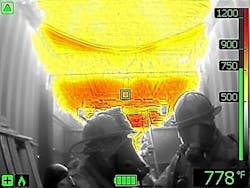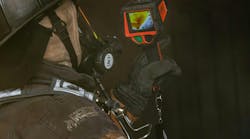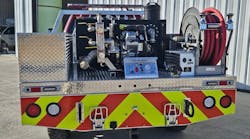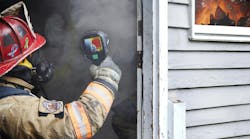When I present a class on thermal imaging cameras (TICs), I find that many attendees have never attended a previous class on thermal imaging—or if they did, it was instructed by a salesperson who taught how to operate it, but not how to use it. I also find that many firefighters are unaware of who should use a TIC or when it should be used. It is imperative to understand the “whys” in order to understand the others Ws to utilize this tool to its fullest capability. In this article, we will address the W’s and shine some light on the topic of thermal imaging.
What is a TIC?
A thermal imager is a tool that detects infrared energy (IR). IR energy is thermal energy, and two-thirds of the earth’s heat is thermal radiation. An object with a temperature above absolute zero (-497 degrees F) emits IR energy. Sir William Herschel measured the temperature of each color of light through a prism. He found that red light was the hottest but then moved his thermometer outside of the prism colors and found the temperatures outside the red prism were hotter then the red. The further away he measured, the hotter the temperature was.
What does a TIC do?
A TIC measures the intensity of the IR thermal spectrum. Eyes see the electromagnetic spectrum like the colors in the rainbow—remember the old ROYGBIV from school (red, orange, yellow, green, blue, indigo and violet)? Those are the colors our eyes can see.
Radio waves are going through the air all the time, but we cannot hear them. When we turn on a radio, it takes those waves and makes them audible to us. A TIC does basically the same thing by taking the IR waves we cannot see and putting them on a screen for us to visualize.
Who should use the TIC?
Unfortunately, this question is usually limited by the number of cameras and the quality of cameras your department has available. Ideally, every firefighter should have a TIC but it is more likely that every team has a TIC. The higher-resolution cameras should be used in interior and RIT operations with your lower-resolution cameras kept with exterior operations. The reasoning is that the better resolution cameras allow us to see “deeper” into a room with better imagery. This is beneficial in search operations. Like the high-resolution cameras, the low-resolution cameras can still be used for flow path location, size-up and water application. We call low-resolution cameras awareness cameras and the high-resolution cameras diagnostic cameras. Of course, a low-resolution camera is still better than no camera at all, so do not disregard these cameras, just know their limitations.
When should the TIC be utilized?
There are many applications where the TIC should be utilized, but we will just touch on the fire scene applications. The TIC should be utilized in size-up. The thermal signatures show the heat locations and direction of the flow path or travel. Is the fire in the attic, traveling up a balloon frame, or is the heat greatest in the Alpha/Bravo corner moving along the Bravo side of the structure? You could also use it to spot heat behind your entry positions and find your easiest access to the fire.
In fire attack, we could use the TIC to find the heat above our heads and like Captain Andrew Starnes says, we can then watch the water erase the heat while making our push. When we get to the fire we can use the TIC to hit the base of the fire. We teach PASS with fire extinguishers and teach sweep the base to put the fire out, why don’t we do the same? With the TIC, we can see the base of the fire and direct the hose stream to extinguish the fire.
There are two ways to direct the hose stream. One way is to hold the TIC in front of the nozzle person and let them maneuver the stream erasing heat and extinguishing the fire. Another way is to communicate where you want the stream to go using a clock technique. If you want the stream to go right, use 3 o’clock, if you want to sweep the fire use 4 to 8 as an example.
In vertical ventilation, we were taught to ventilate as close to over the fire as possible. Utilizing the TIC, we can see where the heat storage is in the roof and where the ventilation hole needs to be. This will assist us by preventing running gases through the roof and allowing heat and fuel to escape at the proper ventilation point.
In search and rapid-intervention operations, remember thermal inversion. What is hottest outside the fire area is not the hottest inside the heated area. In the bay or in fake smoke, victims appear bright on our screen as we are hotter than the environment. In a heated area, victims will appear dark as they are colder than the environment. In a firefighter rescue, bottles and regulators will be dark as they are colder than the environment.
We are taught to go to the fire and work our way back with a search. In a previous article (firehouse.com/21000655), I discuss search techniques with a TIC. Use the point-to-point method to find the flow path and get to the proper search area rapidly, then work your way back.
Where should a TIC be utilized?
The usage of the TIC is limitless based on your imagination. On the fire scene, the TIC should be used for size-ups, search, ventilation and water application. Learning from line-of-duty reports, many fire scene recommendations include utilizing a TIC on size-up, reading fire behavior and search.
Why should the TIC be utilized?
If you still do not see the benefit of utilizing a TIC on the fire scene, I would like to use Michael Whitty’s TIC study to help get the points across. In “Maximising Thermal Imaging Use in the Emergency Services,” Whitty found the TIC has made profound positive enhancements in the fire service. Search time with a TIC dropped 75 percent in finding the victim. Locating the fire room time was cut by 60 percent, and firefighters located an exit 100 percent of the time with a TIC opposed to 70 percent without a TIC. Increased safety, increased efficiency and increased performance—all are reasons to utilize the TIC on the fireground.
Enhance your education
A tool is only as good as the end user. If you do not train on this tool, you will not know how to properly use it. This is no different then the irons, hose management or any other task we perform. Remember, the TIC does not replace your education and experience, it enhances it and it should be a part of our PPE and go everywhere that we go. Stay safe and keep learning.






